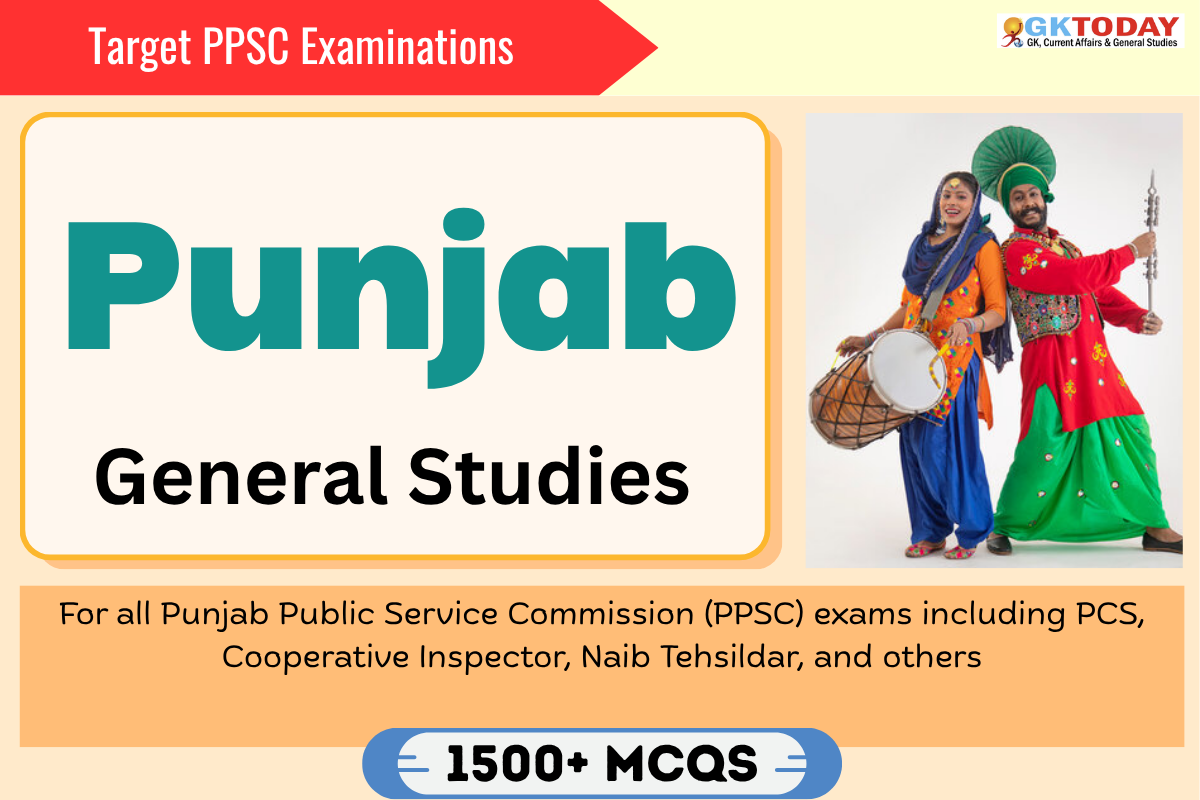States PCS: Punjab GK Questions for PPSC Examinations
For all Punjab Public Service Commission (PPSC) exams including PCS, Cooperative Inspector, Naib Tehsildar, and others.
11. Who is called the Nightingale of Punjab and received the Padma Shri in 2006?
[A] Gurdas Maan
[B] Harbhajan Mann
[C] Surinder Kaur
[D] Surjit Bindrakhia
Show Answer
Correct Answer: C [Surinder Kaur]
Notes:
Surinder Kaur, known as the Nightingale of Punjab, received the Padma Shri in 2006 for her outstanding contribution to Punjabi folk music. She recorded over 2000 songs and helped popularize Punjabi music worldwide. She also received the Sangeet Natak Akademi Award in 1984.
12. Which of the following ancient republics were situated in the Punjab region?
- Kulutas
- Trigartas
- Yakdeyas
Select the correct option from codes given below:
[A] Only 1 & 2
[B] 1, 2 & 3
[C] Only 1 & 3
[D] Only 2 & 3
Show Answer
Correct Answer: B [1, 2 & 3]
Notes:
The ancient republics of Kulutas, Trigartas, and Yakdeyas were all situated in the greater Punjab region. Historical records and archaeological findings confirm the presence and political identity of these tribal republics in North-Western India during early historic times, particularly in the areas corresponding to present-day Punjab and its adjoining territories.
13. Who is the ancient king Parvataka in Mudrarakshasa?
[A] Porus
[B] Ambhi
[C] Dhana Nanda
[D] Seleucus Nicator
Show Answer
Correct Answer: A [Porus]
Notes:
Parvataka in Mudrarakshasa is identified as Porus, the famous king of northwestern India who fought Alexander. Porus allied with Chandragupta Maurya and Chanakya against the Nandas. This alliance is described in Sanskrit and Jain texts, linking him to the Himalayan region.
14. Which city in Punjab hosts Asia’s largest grain market?
[A] Ludhiana
[B] Amritsar
[C] Patiala
[D] Khanna
Show Answer
Correct Answer: D [Khanna]
Notes:
Khanna, in Ludhiana district, Punjab, is known for Asia’s largest grain market, covering extensive trading area, with significant daily arrivals of grains and pulses. Its strategic location and connectivity have established it as the region’s agricultural commerce center. The city is integral to Punjab’s grain trade economy.
15. Which of the following rivers are tributaries of the Beas river?
- Chakki
- Sutlej
- Banganga
Select the correct option from codes given below:
[A] Only 1 & 2
[B] Only 2 & 3
[C] Only 1 & 3
[D] 1, 2 & 3
Show Answer
Correct Answer: C [Only 1 & 3]
Notes:
Chakki and Banganga are tributaries of the Beas river, both flowing mainly through Himachal Pradesh and Punjab. Chakki joins Beas near Pathankot, while Banganga meets Beas near Nagrota. Sutlej is not a tributary of Beas, but an independent river in the Indus system. Hence, only options 1 and 3 are correct.
16. What is the approximate male population of Punjab as per recent data?
[A] 1.46 Crore
[B] 1.31 Crore
[C] 1.15 Crore
[D] 1.62 Crore
Show Answer
Correct Answer: A [1.46 Crore]
Notes:
Punjab’s male population is approximately 1.46 crore, constituting about 52.8% of the state’s total population as per recent estimates.
17. Which Sikh Guru was denied entry to Harmandir Sahib by masands?
[A] Guru Arjan Dev
[B] Guru Tegh Bahadur
[C] Guru Gobind Singh
[D] Guru Hargobind
Show Answer
Correct Answer: B [Guru Tegh Bahadur]
Notes:
Sri Guru Tegh Bahadur Ji, the Ninth Sikh Guru, was denied entry to Harmandir Sahib by the masands (caretakers) in 1664. This happened because the masands had acknowledged Prithi Chand, Guru Arjan Dev Ji’s elder brother, and his descendants as their leaders, under the influence of a rival lineage of impostor gurus (Minas). Guru Tegh Bahadur Ji, upon being refused entry, stayed in a nearby village and later departed, remarking on the ambition of the masands.
18. What is the State Animal of Punjab?
[A] Chinkara
[B] Indian Leopard
[C] Black Buck
[D] Barasingha
Show Answer
Correct Answer: C [Black Buck]
Notes:
Black Buck (Antilope cervicapra) is the State Animal of Punjab, symbolizing agility and grace. It is native to the Indian subcontinent and protected under Indian wildlife laws. Other Punjab symbols include the Baaj (Northern Goshawk) as the State Bird and Shisham as the State Tree.
19. Which city was the capital of PEPSU in Punjab?
[A] Ludhiana
[B] Amritsar
[C] Patiala
[D] Jalandhar
Show Answer
Correct Answer: C [Patiala]
Notes:
Patiala was the capital of Patiala and East Punjab States Union (PEPSU), formed in 1948 after merging several Punjab princely states post-Independence. PEPSU later merged with Punjab in 1956 under the States Reorganisation Act.
20. Who was the first Rajpramukh of PEPSU state in Punjab?
[A] Maharaja Yadvindra Singh of Patiala
[B] Maharaja Jagatjit Singh of Kapurthala
[C] Maharaja Brijinder Singh of Faridkot
[D] Maharaja Sir Harinder Singh Brar of Faridkot
Show Answer
Correct Answer: A [Maharaja Yadvindra Singh of Patiala]
Notes:
PEPSU (Patiala and East Punjab States Union) was formed in 1948, and Maharaja Yadvindra Singh of Patiala served as its first Rajpramukh until 1956. The state included Patiala, Kapurthala, Jind, Nabha, Faridkot, Kalsia, Malerkotla, and Nalagarh.

